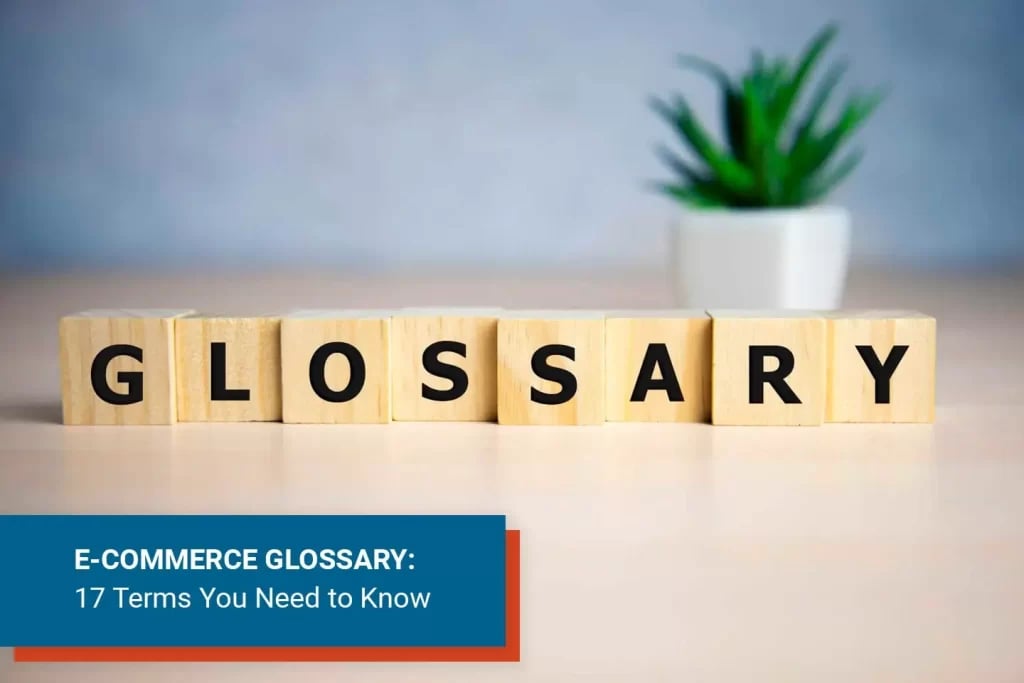E-Commerce Glossary: 17 Terms You Need to Know
 Igor Krasnykh
·
4 minute read
Igor Krasnykh
·
4 minute read

Every industry has its own lingo that those on the inside are familiar with. Expanding your vocabulary is something that will happen naturally as you dive deeper into the eCommerce space. While being introduced to new buzzwords and acronyms for the first time can sound as foreign as hearing another country’s language, learning them is essential if you want to keep up.
Whether you are an industry veteran or just getting started, here are 17 common eCommerce terms you need to know.
1. A/B Testing
Think of AB testing as a measured form of “trial and error” experiments. The tests are conducted by randomly presenting two or more variations of something to customers. From there, businesses are able to analyze which approach led to higher sales conversions.
What is AB testing in action? Let’s say you have a landing page on your website promoting your latest product. You have decided to create two different versions to see which one is more effective. The color scheme, content, layout, and positioning of the call to action are different on each page. Half of all visitors would see one page, and the other half would see the second option. Analytics data would show which page had a higher conversion rate.
2. Average Order Value (AOV)
The average order value is a metric that can be found by dividing total business revenue by the number of individual orders.
3. Business-to-Business (B2B)
B2B brands are businesses that sell products or services to other businesses. Some B2B business examples include accounting software companies, automobile manufacturers, and electrical supply wholesalers.
4. Business-to-Consumer (B2C)
B2C brands get products into the hands of everyday customers. This includes retail stores, car dealerships, and subscription services like Netflix.
5. Big Data
Big data refers to large data sets that must be analyzed by computers to reveal patterns and trends. Businesses can leverage big data to gain insight into customer behavior, for example.
6. Churn Rate
A churn rate (also referred to as customer churn) describes the process of customers leaving your brand. Understanding the circumstances surrounding customer churn can provide valuable insight for improving business processes.
7. Click-through Rate (CTR)
A click-through rate looks at the number of clicks a page receives in relation to the total number of visitors. Dividing clicks by total visitors reveals the CTR. CTRs are commonly used to evaluate the effectiveness of pay-per-click ads.
8. Cross-Selling
When a customer makes a purchase, it makes sense to promote products to them that are similar to or can be used in conjunction with what they are already buying. For example, if someone purchases red and black floor mats for their car, that person may be targeted with an ad for matching seat covers.
9. Customer Relationship Management (CRM)
CRM is a method businesses use to track and manage their interactions with current and potential customers. This is commonly handled through CRM software, such as Salesforce. In addition to organizing customer details (including orders, shipments, and payments), CRM platforms provide helpful data on each account. Because of their proven ability to drive customer retention and sales growth, CRM platforms have become an essential piece of eCommerce success.
10. Customer Retention
A high customer retention rate is something every business strives for. It means that customers continue to do business with your brand over a specific time period. The longer they stick around, the better. Many businesses implement customer retention strategies to be proactive about keeping customers.
11. Key Performance Indicators (KPI)
KPIs are measurements of success. They can be tied to specific projects, activities, employees or overall business goals. KPIs are quantifiable and indicate whether or not certain objectives are being met. Some examples of KPIs include the number of new subscribers in a quarter and the number of blog articles published during a month.
12. Lifetime Customer Value (LCV)
LCV is an estimated dollar amount that is assigned to each customer’s lifecycle. If Julie signs up for a gym membership, the gym may predict that she will spend a total of $1,000 during her time there. Using this figure, it is easier for businesses to determine how much they should be spending to recruit new customers. It also helps them to work toward customer retention goals because it costs more to gain a new customer than it does to retain an existing one.
13. Net Promoter Score (NPS)
A net promoter score is determined by asking customers one question: “On a scale of 1-10, how likely are you to recommend our business to others?” Those who answer 6 or less are called detractors, while 7s and 8s are called passives. Those who give your business a 9 or 10 are known as promoters. If 60% of respondents are promoters while 20% are detractors, your net promoter score is 40.
14. Omni-channel
Omni-channel is a marketing term that describes a cross-channel content strategy used by businesses. Through omnichannel communication, businesses are able to provide a cohesive, integrated customer experience regardless of how or where an interaction happens.
According to Hubspot, “The customer can be shopping online from a desktop or mobile device, or by telephone, or in a brick-and-mortar store, and the experience would be seamless.”
15. Return on Investment (ROI)
ROI is a financial metric that shows the ratio between investment and profit. Remember Julie? The gym she joined predicted her LCV would be $1,000. If they invest an estimated $300 in marketing efforts to acquire each new customer, that means they will receive a $700 ROI from Julie.
16. Search Engine Optimization (SEO)
Search Engine Optimization refers to implementing strategies to make a website more “friendly” for search engines. The friendlier it is, the higher it will organically rank (which leads to more visibility). Using high-ranking keywords in the content and metadata is a common SEO practice.
17. User Experience (UX)
User experience is also referred to as customer experience or CX. UX describes a person’s feelings and attitudes toward a product. It is something many businesses have placed an emphasis on in recent years. For example, you may see a job posting that seeks a UX designer. That means the business is looking to hire someone who is trained to steer user behavior through the usability, accessibility, and desirability they feel while interacting with a product, system, or service.
Maximize your profits with Adobe Commerce Cloud
TechNWeb can help you maximize your ROI from Magento and Salesforce platforms.
- 20+ years of platform experience based on industry and platform best practices
- Focused on growing YOUR profits through automation and overhead reduction
- Prompt communication and short SLAs



